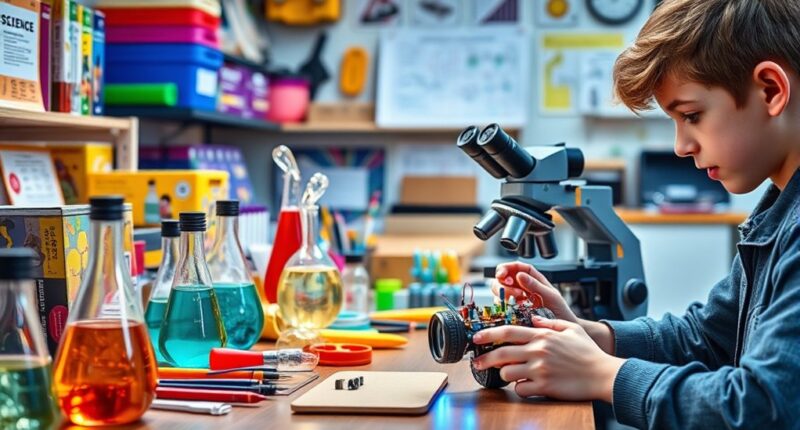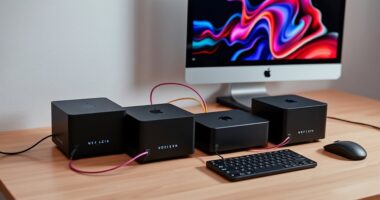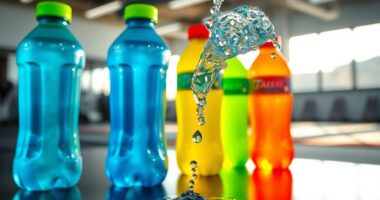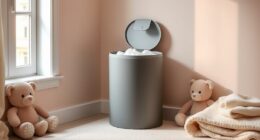If you’re looking for the best science kits that ignite curiosity and boost creativity for teenagers, I recommend options like the Playz Mega Kaboom! for explosive experiments, the UNGLINGA 150 Experiments kit for earth sciences, and the Thames & Kosmos Mega Cyborg Hand for engineering. These kits offer hands-on, engaging projects that cover chemistry, physics, and more, with safe, high-quality materials. Keep exploring to discover the top choices that will inspire young scientists to learn and innovate.
Key Takeaways
- Top science kits offer engaging experiments in chemistry, physics, geology, and electronics, sparking curiosity in teens.
- They include clear instructions, hands-on activities, and age-appropriate challenges to foster creativity.
- High-quality, safe materials and certifications ensure an educational and risk-free experience.
- Many kits feature unique themes like robotics, magnetism, or gross science, appealing to diverse interests.
- They are suitable for independent or guided learning, making them ideal STEM gifts and classroom tools.
Playz Mega Kaboom! Science Experiments Kit for Kids
If you’re looking for a science kit that’s perfect for curious kids aged 8-12 who love explosive experiments, the Playz Mega Kaboom! Science Experiments Kit is an excellent choice. It offers over 150 hands-on activities, like fizzy bombs, balloon rockets, and color explosions, making science engaging and fun. The kit includes a detailed lab guide with step-by-step instructions, pictures, and multimedia content to help kids understand the science behind each experiment. Rated highly by users, it balances safety with exciting reactions, fostering creativity, problem-solving, and curiosity. This kit is a fantastic way to introduce young learners to chemistry and physics through safe, explosive fun.
Best For: curious kids aged 8-12 who love explosive science experiments and want a fun, educational STEM activity.
Pros:
- Engages children with over 150 hands-on experiments that teach chemistry and physics concepts
- Includes a detailed lab guide with step-by-step instructions, pictures, and multimedia content for interactive learning
- Offers safe, explosive reactions that foster curiosity, creativity, and problem-solving skills
Cons:
- Limited chemical supplies may require additional purchases for certain experiments
- Some user reviews mention occasional inaccuracies or basic explanations in the instructions
- The size and chemical variety might not meet the expectations of more advanced science enthusiasts
UNGLINGA 150 Experiments Science Kits for Kids
The UNGLINGA 150 Experiments Science Kits for Kids is an excellent choice for young science enthusiasts enthusiastic to explore a wide range of topics through hands-on activities. With 150 experiments covering earth sciences, surface tension, chemistry, and physics, it offers endless opportunities for discovery. The kit includes a detailed, step-by-step manual with clear instructions, making science accessible and fun at home. All necessary tools and kid-friendly materials are provided, ensuring safe and engaging experiments. This kit encourages curiosity, critical thinking, and a love for STEM, making it a perfect educational gift for curious kids during holidays, birthdays, or free time.
Best For: curious children and parents seeking a comprehensive, safe, and educational science kit to inspire STEM learning through hands-on experiments at home.
Pros:
- Includes 150 diverse experiments covering multiple science topics to keep kids engaged.
- Comes with a detailed, easy-to-follow manual that simplifies complex concepts.
- All necessary tools and materials are provided, ensuring safe and mess-free activities.
Cons:
- The large number of experiments may be overwhelming for some children to complete all at once.
- Some activities might require adult supervision or assistance for younger kids.
- The kit may not include specific household items sometimes needed, requiring additional preparation.
4M Clean Water Science Educational STEM Toy for Kids & Teens
For young science enthusiasts enthusiastic to explore environmental topics, the 4M Clean Water Science STEM Toy stands out as an engaging and educational choice. This kit demonstrates the process of extracting salt from seawater, helping kids understand desalination and water purification. It includes a plastic filter system, active carbon, sand, rock, and filter paper, providing hands-on experience. Suitable for ages 8 and up, it encourages curiosity about environmental science and promotes practical learning. This kit challenges imagination while developing essential scientific skills, making it perfect for kids and teens interested in STEM, water treatment, and climate change solutions.
Best For: young science enthusiasts aged 8 and up interested in environmental science, water purification, and STEM education.
Pros:
- Engages kids and teens with hands-on experiments that demonstrate desalination and water treatment processes.
- Promotes learning about environmental issues like climate change through practical activities.
- Includes comprehensive materials and instructions, fostering scientific skills and curiosity.
Cons:
- May require adult supervision for younger children during setup and experiments.
- Limited to salt extraction from seawater; may not cover broader water purification methods.
- Some parts, like filter paper or small components, could be easily misplaced or lost.
Thames & Kosmos Mega Cyborg Hand STEM Kit
Designed for tech-savvy teens enthusiastic to explore engineering, the Thames & Kosmos Mega Cyborg Hand STEM Kit stands out with its realistic, wearable robotic hand operated solely by air pressure, water, and manual movements. You can build a functional hand with adjustable joints and three configurations—right, left, or claw—fitting various hand sizes. Using hydraulic pistons, it simulates how real robotic hands grip and lift objects, teaching principles of pneumatic and hydraulic systems. Since it doesn’t require motors or batteries, it emphasizes fundamental fluid power concepts. Recognized as the 2021 STEAM Toy of the Year, it’s an engaging way to immerse yourself in robotics and engineering fundamentals.
Best For: tech-savvy teens and educators interested in hands-on robotics, engineering principles, and STEM learning through realistic hydraulic and pneumatic systems.
Pros:
- Realistic, wearable robotic hand that demonstrates hydraulic and pneumatic system operation
- Adjustable joints and multiple configurations for varied hand sizes and functions
- No motors or batteries required, promoting fundamental engineering understanding
Cons:
- Requires careful assembly and adjustment, which may be challenging for younger users
- Limited to pneumatic and hydraulic mechanisms, with no electronic or motorized features
- May be less suitable for users seeking fully electronic or programmable robotic kits
4M Kidzlabs Magnetic Levitation Science Kit
If you’re looking to spark a teen’s interest in physics and magnetism, the 4M Kidzlabs Magnetic Levitation Science Kit is an excellent choice. It offers hands-on experiments that demonstrate magnetic forces, such as floating a pencil, levitating screws, and building a maglev train. All necessary materials come included, along with detailed instructions to guarantee safe and successful experimentation. Designed for kids and teens aged 8 and up, this kit challenges their imagination while teaching key scientific principles. It’s a fun way to promote curiosity, critical thinking, and a deeper understanding of physics, making STEM learning engaging and inspiring.
Best For: kids and teens aged 8 and up who are interested in exploring physics, magnetism, and STEM concepts through engaging, hands-on experiments.
Pros:
- Provides interactive, educational activities that promote understanding of magnetic forces and physics principles
- All necessary materials and detailed instructions included for safe, successful experiments
- Encourages curiosity, critical thinking, and creative problem-solving skills in young learners
Cons:
- May require adult supervision for younger children to ensure proper use
- Limited to basic magnetic levitation experiments, which might not satisfy advanced learners seeking more complex challenges
- The kit’s durability and quality of included materials can vary, possibly affecting long-term use
NATIONAL GEOGRAPHIC Science Magic Kit for Kids
The NATIONAL GEOGRAPHIC Science Magic Kit for Kids stands out as an excellent choice for young science enthusiasts enthusiastic to explore chemistry, physics, and magic tricks. With over 100 experiments, including 20 magic tricks like making snow and bending metals, it offers endless fun and learning. The kit includes all necessary materials, a magic wand, gloves, and detailed instructions, making experiments easy and safe. Recognized with the Toy of the Year Award, it fosters curiosity, critical thinking, and creativity. Perfect for kids 8 and up, it’s a fantastic way to engage children in hands-on STEM activities at home or school.
Best For: children aged 8 and up who are interested in exploring science, magic tricks, and STEM activities through hands-on experiments at home or school.
Pros:
- Over 100 engaging experiments that foster curiosity and critical thinking
- Includes all necessary materials, instructions, and bonus activities for extended learning
- Recognized with awards and high customer ratings, ensuring quality and educational value
Cons:
- Some ingredients may need to be discarded after opening, requiring resealable storage
- Younger children may require adult supervision to ensure safety during experiments
- The kit’s size and contents may be less suitable for very young children or limited space
National Geographic Chemistry Set with 45 Science Experiments
Looking for a science kit that turns curious teens into young chemists? The National Geographic Chemistry Set with 45 experiments delivers just that. It offers a wide variety of activities, from creating bubbling solutions to glowing test tubes and colorful bouncy balls. With over 15 experiments plus 30 bonus activities using household items, it’s perfect for hands-on learning. The kit includes clear, illustrated instructions and real scientific tools like test tubes and pipettes, making experiments accessible and engaging. Built with quality and safety in mind, this set inspires exploration, fostering curiosity and practical skills in chemistry. It’s an excellent STEM gift for aspiring young scientists.
Best For: curious teens and young aspiring chemists eager to explore science through hands-on experiments and engaging activities.
Pros:
- Includes 45 diverse experiments, offering extensive STEM learning opportunities
- Comes with clear, illustrated instructions that make complex concepts accessible
- Features real scientific tools like test tubes and pipettes to enhance practical skills
Cons:
- May require adult supervision for younger children due to handling of scientific materials
- Some experiments might involve small parts that pose a choking hazard for very young kids
- The need for household items for bonus activities could be inconvenient for some users
Thames & Kosmos Chemistry Chem C500 Science Kit
Are you searching for a chemistry kit that balances engaging experiments with educational value for teenagers? The Thames & Kosmos Chemistry Chem C500 Science Kit is an excellent choice. It offers 28 guided experiments involving solids, liquids, gases, acids, and bases, all explained with a clear, full-color manual. Kids can explore reactions like invisible ink, fizzing reactions, and colorful effects, promoting hands-on learning and curiosity. Suitable for ages 10-15, it helps develop scientific thinking, understanding of lab procedures, and inquiry skills. While some household items are needed, the kit delivers a fun, educational experience that sparks interest in chemistry and science concepts.
Best For: Teenagers and young science enthusiasts aged 10-15 who want a hands-on, educational introduction to chemistry with guided experiments and clear explanations.
Pros:
- Offers 28 engaging experiments covering solids, liquids, gases, acids, and bases, fostering curiosity and understanding of chemical reactions.
- Includes a comprehensive 48-page full-color manual with simple instructions and explanations to support independent or guided learning.
- Promotes development of scientific thinking, lab procedure familiarity, and inquiry skills in a safe and fun way.
Cons:
- Requires additional household items like water, vinegar, and batteries, which are not included in the kit.
- Chemicals are provided in limited quantities, possibly necessitating purchase of extra supplies for extended experiments.
- Some users report the manual may be damaged or outdated, and supervision is recommended due to the use of chemicals and glassware.
4M Crystal Growing Science Kit for Kids and Teens
If you’re a young science enthusiast interested in geology or hands-on experiments, the 4M Crystal Growing Science Kit for Kids and Teens is an excellent choice. It includes everything needed to perform seven crystal growth experiments, complete with clear instructions and a display case to showcase your crystals. Using hot water, preferably distilled, you’ll grow stunning crystals and learn about the science behind their formation. Designed for kids aged 10 and up, this kit encourages curiosity, creativity, and educational fun at home or in the classroom. Its compact design makes it easy to observe and admire your beautiful crystal creations.
Best For: young science enthusiasts aged 10 and up interested in geology, hands-on experiments, and educational STEM activities.
Pros:
- Includes materials and instructions for seven crystal growth experiments, providing comprehensive learning opportunities.
- Features a display case to easily observe and showcase crystals, enhancing visual appreciation.
- Promotes safe, easy, and engaging DIY activities suitable for home or classroom use.
Cons:
- Requires hot water, preferably distilled, which may not be readily available for all users.
- Limited to crystal growing activities, so it may not appeal to those seeking a broader range of science experiments.
- For younger children under 10, supervision may be needed to ensure proper handling of materials and safety.
National Geographic Gross Science Kit for Kids
The National Geographic Gross Science Kit for Kids stands out as an ideal choice for young science enthusiasts aged 8 to 12 who enjoy hands-on, gross-themed experiments. With 45 fun activities like dissecting a brain, making slime, and testing household items, it keeps kids engaged and learning. The kit explores concepts like polymers, chemical reactions, and pH science through entertaining experiments such as boiling boogers and glowing worms. Clear, illustrated instructions make each activity easy to follow, ensuring a safe and educational experience. Plus, the bonus booklet encourages further exploration at home, making this kit perfect for curious kids enthusiastic to discover science in a fun, gross way.
Best For: kids aged 8-12 who love gross, hands-on science experiments that make learning fun and engaging.
Pros:
- Offers 45 gross and educational experiments to stimulate curiosity and STEM skills.
- Clear, illustrated instructions make activities easy and safe for kids to follow independently.
- Includes a bonus booklet with household experiments, encouraging further exploration at home.
Cons:
- Some experiments may require adult supervision, especially for younger children.
- The kit’s gross themes might not appeal to all children or parents seeking traditional science kits.
- The variety of experiments could be overwhelming for some kids who prefer more focused activities.
STEM Projects Kit: Build Your Own Bluetooth Speaker for Kids & Adults
Designed for beginners and experienced hobbyists alike, the STEM Projects Kit allows users to build their own Bluetooth speaker effortlessly, making it an ideal choice for teenagers interested in electronics and sound technology. With clear instructions and no soldering required, assembling this stylish wooden speaker takes about 30 minutes, offering a fun, hands-on learning experience. It features a 3W per channel output, Bluetooth connectivity, and electronic components that demonstrate how speakers work. Powered by 4 AA batteries (not included), this durable, reusable kit promotes critical thinking, problem-solving, and creativity—perfect for fostering STEM skills while enjoying a rewarding, engaging project.
Best For: beginners and hobbyists of all ages interested in learning about electronics, sound technology, and STEM concepts through a hands-on building experience.
Pros:
- Easy to assemble with clear instructions; no soldering required.
- Promotes STEM learning, problem-solving, and creativity in a fun project.
- Durable, reusable design with quality components and stylish wooden shell.
Cons:
- Batteries are not included, requiring an additional purchase.
- Sound quality may be basic and not high-end for audiophiles.
- Assembly time is approximately 30 minutes, which may be longer for some users.
“Hydrobot Arm Kit”, Hydraulic Kit, STEM Building Toy for Kids 12+
The Hydrobot Arm Kit is an excellent choice for teenagers interested in hands-on engineering projects that don’t require batteries. It teaches mechanical engineering through building a real, working hydraulic robot with a 6-axis arm capable of 270-degree rotation. Kids learn to control the gripper, which can open and close or pick up objects with optional suction cups. Powered solely by water hydraulics, it harnesses water pressure to operate, making it environmentally friendly and simple to use. Designed to promote problem-solving, critical thinking, and curiosity, this STEM kit offers practical skills in robotics, hydraulics, and engineering, making learning both engaging and rewarding.
Best For: Teenagers and young learners interested in hands-on STEM projects, robotics, and hydraulics without the need for batteries.
Pros:
- Teaches practical mechanical engineering skills through real robot assembly.
- Uses water hydraulics, making it eco-friendly and easy to operate without batteries.
- Enhances critical thinking, problem-solving, and curiosity in a fun, engaging way.
Cons:
- Requires adult supervision for younger children during assembly.
- May have a learning curve for complete beginners unfamiliar with hydraulics.
- Limited to water-based operation, which may restrict use in certain environments or require clean water maintenance.
National Geographic Chemistry Set – STEM Science Kit for Kids 8-12
If you’re looking for an engaging science kit for kids aged 8-12, the National Geographic Chemistry Set stands out as an excellent choice. It offers 45 hands-on experiments, including eruptions, geysers, rockets, and chemical reactions, all designed to spark curiosity and teach fundamental chemistry concepts. The kit includes everything needed for multiple activities, with clear, illustrated instructions that make complex ideas accessible. Kids can perform experiments independently or with minimal supervision, making it perfect for curious learners. Customers rave about its quality, educational value, and ability to keep children entertained while fostering a love for science.
Best For: inquisitive children aged 8-12 who enjoy hands-on science experiments and want to learn fundamental chemistry concepts in a fun and engaging way.
Pros:
- Offers 45 easy-to-conduct experiments that foster curiosity and scientific skills
- Includes comprehensive, illustrated instructions suitable for independent use
- High-quality materials and positive customer feedback on educational value and entertainment
Cons:
- Limited chemical supplies may restrict repeated use of certain experiments
- Instructions are only provided in English, which may pose challenges for non-English speakers
- Some users find the chemical reactions somewhat basic for advanced learners
Robot Building Kit for Kids Aged 8-16 with APP or Remote Control
For parents and teens seeking an engaging, hands-on STEM project, the Robot Building Kit for Kids Aged 8-16 stands out with its versatile APP and remote control options. It includes over 468 building pieces, promoting creativity, problem-solving, and fine motor skills. The robot can be controlled via Bluetooth phone app or 2.4GHz remote, with modes like path, voice, gravity sensor, and programming. Its flexible joints, glowing eyes, and 360° rotation make play interactive and fun. The kit’s organized packaging, detailed manual, and durable, non-toxic materials guarantee easy assembly, safety, and long-lasting enjoyment for young robot enthusiasts.
Best For: Parents and teenagers aged 8-16 seeking an engaging, educational, and interactive STEM-building robot kit that combines creativity, problem-solving, and safe, easy assembly.
Pros:
- Includes over 468 building pieces with stickers, fostering creativity and hands-on learning.
- Multiple control modes (APP Bluetooth, remote control, voice, gravity sensor, programming) for varied interactive play.
- Made from durable, non-toxic ABS materials with safety features like smooth edges and flexible joints.
Cons:
- Assembly may require adult supervision for younger children due to complexity.
- The electronic components depend on compatible devices (smartphone or remote), which might limit play options if unavailable.
- Some users may find the setup manual less detailed for beginners unfamiliar with DIY robot building.
Factors to Consider When Choosing Science Kits for Teenagers

When selecting a science kit for a teenager, I always consider whether it’s suitable for their age and skill level to ensure they stay engaged without feeling overwhelmed. Safety standards are vital, so I look for kits with quality materials and clear instructions to prevent accidents. Finally, I check the educational content and complexity to match their curiosity and experience, making sure the kit is both fun and informative.
Age Appropriateness
Choosing the right science kit for a teenager depends heavily on ensuring it matches their age and developmental stage. I look for kits designed specifically for their age range to match their cognitive abilities and curiosity. The complexity should strike a balance—challenging enough to stimulate learning but not so difficult that it becomes frustrating. I also check that safety instructions and materials are appropriate for their maturity level to prevent accidents. The instructions should suit their reading and comprehension skills, providing clear guidance. ultimately, I consider their interests and education level, choosing kits that will keep them engaged and motivated. Age-appropriate kits help foster a love of science while ensuring the experience is both safe and rewarding.
Safety Standards
Ensuring safety standards are met is essential when selecting science kits for teenagers, as it directly impacts their well-being during experiments. I always check if the kit complies with ASTM F963 or EN71 safety standards, which guarantee all materials are non-toxic and safe. It’s important that the kit includes safety gear like goggles and gloves, along with clear instructions on proper handling to prevent injuries. I also verify that chemicals and substances are pharmaceutical or food-grade quality, minimizing exposure to hazardous materials. Additionally, I look for clear age-appropriate warnings and labels that outline safety precautions. Certified electrical components and mechanical parts are critical too, as they reduce risks of shocks or mechanical failures. Prioritizing these safety factors helps guarantee a secure and enjoyable learning experience.
Educational Content
Have you ever wondered if a science kit truly helps teens understand the core principles of science? I believe it does, but only if the educational content is solid. Look for kits that include detailed manuals, step-by-step instructions, and visual aids, so teens can learn independently with confidence. It’s important that experiments cover a wide range of scientific topics—like chemistry, physics, biology, and environmental science—to foster a well-rounded STEM understanding. Safety should also be a priority; the kit must emphasize age-appropriate experiments with clear safety guidelines and risk explanations. Plus, supplementary multimedia resources such as videos or interactive guides can boost engagement and deepen comprehension. When choosing a kit, guarantee it offers thorough, accurate, and diverse educational content to truly inspire curiosity.
Material Quality
When selecting a science kit for teenagers, material quality plays a vital role in guaranteeing safe and effective experiments. High-quality materials guarantee safety, durability, and reliable performance, making the learning experience both enjoyable and secure. Sturdy construction with non-toxic, chemical-resistant components reduces the risk of accidents and damage during use. Good material standards also help produce consistent results and prevent contamination or chemical leaks that could compromise experiments. Durable, well-made kits withstand repeated use, offering better value and supporting long-term educational engagement. Additionally, look for certifications like ASTM or CE, which indicate that the materials meet strict safety and quality standards. Prioritizing material quality ensures your teen has a safe, effective, and satisfying scientific exploration.
Complexity Level
Choosing the right science kit for teenagers means matching the complexity of the experiments to their skill level. You want kits that challenge them without causing frustration, so look for sets with clear, detailed instructions suited for their understanding. Consider how complicated the tools and materials are—kits that require some assembly and handling of scientific equipment are ideal, as they build practical skills. It’s helpful to choose kits with a progression of difficulty, allowing teenagers to grow their confidence and knowledge over time through increasingly complex projects. Be mindful of whether the teen has the necessary background or supervision, especially with more advanced experiments. The goal is to find a balance that stimulates curiosity while remaining accessible and engaging.
Price and Value
Evaluating the price and value of a science kit is essential to guarantee you’re getting the most for your money. I look at the number and complexity of experiments included to see if they justify the cost. High-quality materials and durable tools often come at a higher price but can enhance the learning experience. I also consider whether the kit offers extra resources like manuals, videos, or online support, which add educational value without extra charges. Comparing the price per experiment helps determine if the kit is a cost-effective way for teens to explore multiple scientific concepts. Ultimately, I watch out for hidden costs, such as additional supplies or chemicals needed, which can impact the overall value. This approach helps ensure I choose a kit that offers both quality and affordability.
Frequently Asked Questions
What Safety Precautions Are Included in These Science Kits?
The science kits I recommend include safety goggles, gloves, and clear instructions to guarantee safe experimentation. I always emphasize wearing protective gear and working in well-ventilated areas. The kits also have age-appropriate materials and step-by-step guides, so teens can learn safely and confidently. I believe safety is the top priority, and these precautions help foster curiosity while preventing accidents during science explorations.
Are These Kits Suitable for Beginners or Advanced Learners?
These kits are perfect for both beginners and more advanced learners. I love how they include clear instructions for newcomers, making science accessible and fun. At the same time, they offer complex experiments that challenge experienced teens, sparking deeper curiosity. Whether you’re just starting out or looking to push your skills further, these kits adapt to your level, keeping you engaged and excited to explore science at every step.
Can These Kits Be Used Independently by Teenagers?
Absolutely, many of these science kits are designed for independent use by teenagers. I’ve found that they provide clear instructions and enough materials for self-guided exploration. Teenagers can often work through the projects on their own, fostering confidence and curiosity. However, some kits might require adult supervision, especially for younger teens or more complex experiments. Overall, they’re fantastic tools for independent learning and discovery.
Do All Kits Include Comprehensive Instructions and Tutorials?
Most science kits I’ve seen include detailed instructions and tutorials, making them easy to use independently. These guides often feature step-by-step directions, safety tips, and explanations of scientific concepts, which really help teenagers learn and stay engaged. I recommend checking each kit’s details before purchasing, but generally, you’ll find thorough instructions that support independent exploration and foster curiosity in young scientists.
How Do These Kits Enhance Creativity Beyond Basic Science Concepts?
Think of these kits as a painter’s palette—more than just colors, they inspire endless creativity. I’ve seen teens transform simple experiments into unique inventions, like customizing a robot or designing eco-friendly solutions. These kits encourage divergent thinking, problem-solving, and innovation, pushing beyond basic concepts. They turn science into an open-ended adventure, fueling curiosity and personal expression, and helping teens realize their potential to create and explore beyond textbook boundaries.
Conclusion
Choosing the right science kit can truly ignite a teen’s passion for discovery. Imagine a teenager like Sarah, who built the Hydrobot Arm and now dreams of becoming an engineer. By selecting a kit that matches their interests and skill level, you’re helping them develop critical thinking and creativity. Whether it’s exploring chemistry or robotics, the right kit can turn curiosity into a lifelong love of science.
























